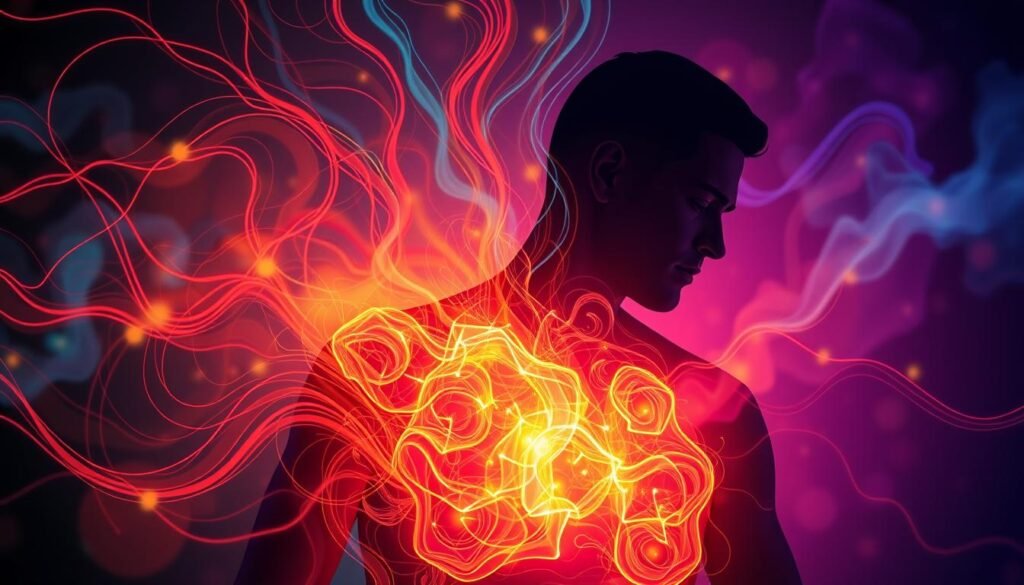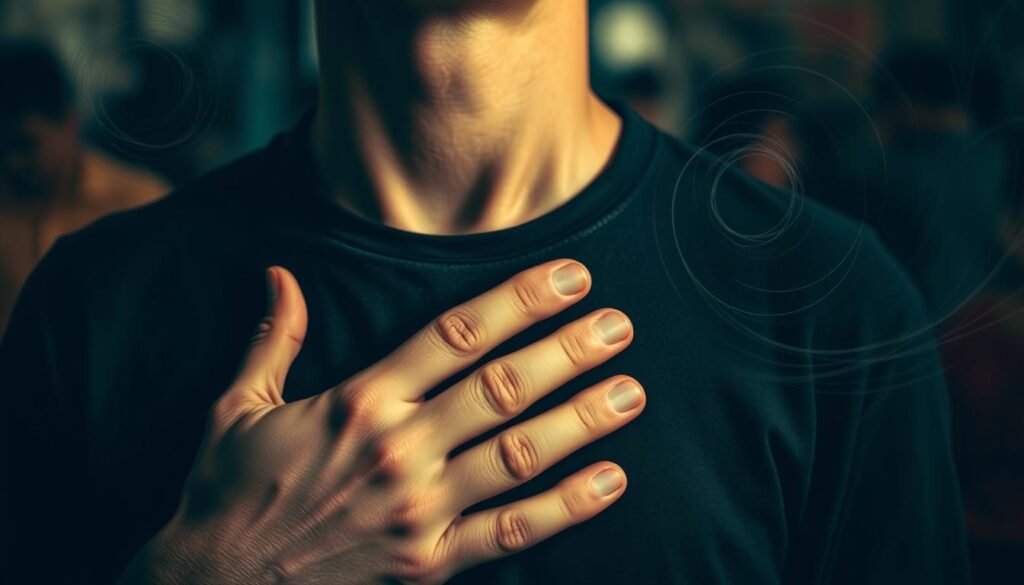An astonishing 25 to 50 percent of people who go to the ER for chest pain actually have moderate to severe anxiety. This was found in a study done in 2018. It’s a big wake-up call: chest pain can really be a sign of anxiety, not just heart issues. In fact, around half of those who rush to the ER fearing a heart problem don’t have one. Recognizing chest pain from anxiety is key. It helps people figure out the real reason for their discomfort and what steps to take next. This piece dives into how anxiety and physical symptoms are connected. It aims to clear up how anxiety affects the body and highlight why it’s vital to understand psychosomatic symptoms during anxious times.
Key Takeaways
- Chest pain linked to anxiety can vary widely, manifesting as sharp pains, persistent aches, or sensations of tightness.
- Many individuals with anxiety may mistakenly believe they are experiencing a heart attack when it’s actually anxiety-induced symptoms.
- Utilizing coping techniques such as deep breathing and visualization can effectively manage anxiety-related chest pain.
- A substantial percentage of patients presenting with chest pain do not have a heart issue and may be dealing with anxiety instead.
- Understanding the signs of anxiety-related symptoms is crucial for individuals to differentiate between anxiety and cardiac problems.
Introduction to Anxiety and Chest Pain
Anxiety is a natural response to threats we sense around us. It is deeply wired into our human nature. Because of this, people can feel chest pain when anxious, viewing it as a major alert. It’s important to know that our emotions can make our bodies react. So recognizing these signs is key for timely and correct treatment. Studies show that 30% to 40% of emergency visits for low-risk chest pain are anxiety-related.
The physical signs of anxiety, like chest pain, can appear without warning. People often feel a sharp pain that doesn’t last more than 10 minutes. This pain comes from certain stress reactions in our body. These reactions include a faster heartbeat and higher blood pressure due to adrenaline and cortisol. Although these signs can seem like heart problems, they might also come from other issues, such as esophageal dysmotility or breathing too fast.
There’s a clear difference between the chest pain from anxiety and that from heart issues. Anxiety-related pain is sudden, with shakes or dizziness, unlike the slow, squeezing pain of heart attacks. Knowing this difference helps people get the right medical help. It also helps rule out serious conditions while easing worries.
Understanding Chest Pain as a Symptom of Anxiety
Anxiety can show itself in many ways, including chest pain. About 30% of adults will face an anxiety disorder at some point. This makes it a common issue. The link between anxiety symptoms and physical feelings often leads people to check for heart problems.
Overview of Anxiety-Related Physical Symptoms
Anxiety symptoms can change how a person lives each day.
- Increased heart rate
- Chest pain or discomfort
- Hyperventilation
- Sweating and trembling
- Dizziness or nausea
In panic disorder cases, chest pain appears in up to 80% of episodes. People with Generalized Anxiety Disorder (GAD) also feel similar pains. These symptoms can worry someone and make it hard to know the cause.
Distinguishing Between Anxiety and Heart Conditions
Knowing the difference between anxiety and heart conditions is essential. Both can cause chest discomfort. So, we must look closely at the pain’s nature.
| Symptoms | Anxiety-Related | Cardiac-Related |
|---|---|---|
| Quality of Pain | Sharp, dull, or tight | Pressure, squeezing, or heavy |
| Associated Symptoms | Lightheadedness, sweating, shortness of breath | Nausea, fatigue, radiating pain |
| Triggers | Stress or anxiety | Physical exertion, emotional distress |
Looking at these factors helps doctors make the right call on tests. Understanding that anxiety can cause chest pain ensures patients get the correct help.
What Anxiety Chest Pain Feels Like
People who feel anxiety-induced chest tightening describe it differently. Some say it’s sharp and stabbing. Others talk about a constant ache in their chest. There are also those who feel a burning sensation or vague pressure. It’s like carrying a heavy weight on their chest. These explanations help tell if the pain is from anxiety or something more serious, like a heart issue. About 58% of chest pain cases are due to anxiety or panic attacks. This shows there’s a big overlap between feeling stressed and having physical symptoms.
Common Descriptions of Anxiety-Induced Chest Pain
Common descriptions of chest pain from panic attacks include discomfort that spreads to arms, neck, jaw, back, or stomach. People also report a fast heartbeat and sweating. These symptoms together can feel very distressing. The pain from anxiety can differ a lot in how severe and how long it lasts. Some people get sudden, sharp pain. Others have a milder pain that stays for hours or even days.
Variability of Symptoms in Different Individuals
Different people experience anxiety chest pain in their own ways. This depends on their emotions and general health. One person might feel a sharp, sudden pain. Another might describe their pain as mild but lasting a long time. Because people feel pain differently, it’s hard to know if it’s from anxiety or a heart problem. When dealing with these symptoms, it’s important to get advice that’s right for you. This could be medical help or psychological support. To understand how anxiety can cause physical symptoms, check out this resource.
Chest Pain vs. Heart Attack Symptoms
Knowing about chest pain is vital for health-related issues, especially with anxiety and possible heart problems. It can be hard to tell the difference between anxiety and heart attack pain. This often leads to confusion. Knowing the differences is key for taking the right steps when dealing with chest pain.
How to Differentiate Anxiety Chest Pain from Cardiac Pain
Panic attacks can cause chest pain in many people. Heart attack symptoms, however, often show up as tightness in the chest. This mostly happens on the left side or under the breastbone. To tell the two apart, look for clues like:
- Duration of Symptoms: Symptoms from panic attacks usually go away quickly. Heart attack symptoms might stay or get worse.
- Triggering Factors: Panic attacks can be set off by emotional stress. Physical effort might lead to heart attack symptoms.
- Location of Pain: Chest pain from anxiety usually stays in one spot. Pain from heart issues might spread to arms, back, or jaw.
Dr. Blackburn says that certain pain traits can help tell panic attacks apart from heart attacks. Knowing the difference can lead you to get emergency help for chest pain when it’s necessary.
When to Seek Emergency Medical Attention
Chest pain always needs to be looked at carefully. Remember to consider the patient’s history, especially if it’s their first time. If symptoms appear, it’s crucial to get medical help right away to find out what’s wrong and start treatment. Signs that you need urgent care include:
| Symptoms | Recommendation |
|---|---|
| Severe chest pain | Seek emergency care immediately. |
| Shortness of breath | Consult medical personnel at once. |
| Pain radiating to arms, back, or jaw | Do not delay in seeking emergency help. |
| Cold sweats, nausea, or lightheadedness | Immediate evaluation is necessary. |
Being proactive with your health leads to fast action in possible heart emergencies. If you have chest pain, don’t wait to get help. It’s important to figure out the cause and get the right treatment.

Causes of Anxiety-Induced Chest Pain
Anxiety can cause chest pain through a mix of mental and body reactions. It’s key to know these causes. This helps tell apart anxiety from heart-related issues.
Body’s Reaction During Anxiety: Fight-or-Flight Response
When you’re anxious, your body may trigger a fight-or-flight response. This gets you ready to deal with threats. Stress hormones like cortisol and adrenaline increase. They make your heart rate and blood pressure go up. This can lead to chest pain.
During anxiety, you might feel sharp chest pain. It is usually in the center or left side. This pain is different from heart-related pain, which can spread to the shoulder or arm.
Understanding Psychosomatic Symptoms
Anxiety shows how your mind can affect your body, including causing chest pain. This link between the mind and body means anxiety can create real physical issues. However, these don’t always signal severe health problems.
Where the pain is, what it feels like, and what triggers it can help tell anxiety apart from other issues. Not dealing with chronic anxiety might lead to bigger health risks, like heart disease. Using relaxation methods, eating well, and exercising can help manage anxiety symptoms.
Anxiety Disorder Symptoms Related to Chest Pain
Anxiety disorders include many complex conditions. They often come with various physical symptoms. One key symptom is chest pain, which can show up during intense anxiety moments. Understanding the link between chest pain and panic disorder helps people better recognize their anxiety symptoms. It also encourages them to get the right help.
Panic Disorder and Its Association with Chest Pain
Panic disorder is marked by sudden panic attacks. These attacks can cause a lot of stress and confusion. This is especially true if chest pain appears with other symptoms during these attacks. Many people feel chest pain during their attacks, with rates noted between 20% to 70%. With such high rates, it’s hard to tell if chest pain comes from anxiety or heart problems. This confusion can lead to more fear and worry.
Bodily Responses: A Look at Hyperventilation and Muscle Tension
Many experience hyperventilation during panic attacks. This causes rapid breathing that can make chest pain worse. Such reactions can lead to dizziness and a tight chest, often because of muscle tension from anxiety. Knowing these physical reactions is key to handling panic attacks well. Managing hyperventilation can reduce panic attacks and related chest pain, improving overall health.

Home Remedies and Coping Techniques
Dealing with anxiety-induced chest pain can be difficult. Effective home remedies and coping strategies help a lot. Deep breathing is key in managing anxiety.
These methods are comforting and let people take back control during stress.
Deep Breathing and Mindfulness Practices
Deep breathing is vital for easing anxiety-related chest pain. Practices like box breathing and pursed lip breathing slow the heart rate and relax muscles. Mindfulness, including meditation and visualization, helps focus the mind.
These techniques allow focusing on the now, shifting attention from anxiety.
When to Consider Professional Help
Sometimes, dealing with anxiety and chest pain is too much. When symptoms interfere with daily life, seeking therapy is a good step. Professional help offers tailored strategies and therapeutic interventions for anxiety.
Working with a mental health professional boosts your coping skills. It provides support and strengthens resilience against stress-related symptoms.
| Coping Strategy | Description | Benefits |
|---|---|---|
| Deep Breathing Techniques | Controlled breathing patterns that help reduce anxiety and chest tightness. | Encourages relaxation, lowers heart rate, and diminishes muscle tension. |
| Mindfulness Meditation | A practice focusing on the present moment to reduce racing thoughts. | Improves emotional regulation and enhances overall well-being. |
| Seeking Therapy | Consulting a mental health professional for personalized strategies. | Provides tailored support and effective coping mechanisms for anxiety. |
Medications and Therapies for Anxiety-Related Chest Pain
Managing chest pain from anxiety takes multiple steps, including medication and therapy. Knowing which treatments work best can really help improve well-being.
Pharmacologic Treatments: SSRIs and Benzodiazepines
SSRIs are often used to treat chest pain linked to anxiety. They work by balancing mood and lessening panic symptoms. This reduces uncomfortable feelings in the chest. Nearly 40 million Americans might get chest pain from anxiety, showing how vital effective treatments are.
Benzodiazepines also treat anxiety but are mostly for short-term use. They can quickly help in emergencies but have a risk of addiction. Doctors usually suggest SSRIs first to avoid long-term risks. It’s important to understand your options. You can learn more about these medications here.
Psychotherapy: The Role of Cognitive Behavioral Therapy (CBT)
CBT is key for treating anxiety, especially when it causes chest pain. It targets harmful thought patterns and fears. Patients learn how to deal with anxiety triggers better. CBT provides lasting benefits, even more than medications alone.
With CBT, patients pick up various coping methods. Pairing it with medication, CBT supports a healthier mind and fewer panic attacks. The combination of treatments is crucial for a personalized anxiety plan.

| Treatment Type | Description | Pros | Cons |
|---|---|---|---|
| SSRIs | Selective serotonin reuptake inhibitors stabilize mood and reduce anxiety symptoms. | Effective for long-term anxiety management; lower risk of dependency. | Takes time for effects to kick in; possible side effects like nausea. |
| Benzodiazepines | Provide rapid relief for anxiety and panic symptoms. | Fast-acting; beneficial for short-term crises. | Higher risk of tolerance and addiction; not for long-term use. |
| CBT | Therapeutic approach that alters negative thought patterns. | Empowers patients; provides tools for long-term recovery. | Requires time and commitment; effectiveness varies by individual. |
Using medicine and therapy together offers a full-plan approach to tackle chest pain from anxiety. This active involvement helps people overcome their issues and enhances their life quality.
Signs of Anxiety-Triggered Coronary Spasms
Anxiety-triggered coronary spasms present a unique challenge. It’s tricky to spot stress-related angina symptoms. Knowing how they differ from other heart issues is key. Anxiety’s effect on the heart shows why it’s vital to understand physical signs of stress.
Understanding Stress-Related Angina
Stress can make arteries narrow, causing stress-related angina. This might happen without any physical activity and cause severe chest pain. About 17% of angina patients have spasms even if their arteries aren’t blocked.
Signs like a burning feeling, pressure, or squeezing in the chest are common. Spotting these is crucial. They can spark anxiety or panic attacks, creating a stressful loop.
The Mind-Body Connection in Heart Health
The idea of mind-body connection heart health shows how our mental state affects our physical health. Long-term anxiety can worsen heart problems or cause new ones. This connection points to the need for a healthy lifestyle and stress management.
Not everyone with anxiety has usual risk factors like high cholesterol. But they might still face cardiac symptoms anxiety. Actions towards managing stress and making healthier choices can boost heart health.
For more about how anxiety and coronary spasms are linked, check out this article here.
Conclusion
Knowing that chest pain can be a sign of anxiety is crucial. It helps in dealing with anxiety symptoms and emotional upset. Studies show that 30-40% of visits to the emergency room for chest pain are actually because of anxiety. Recognizing this link lets people take active steps towards getting better. They can find ways to cope and look for help that relieves both their mind and body.
Moreover, people with noncardiac chest pain, especially if they have panic or generalized anxiety disorder, often feel more pain. They also see their life quality go down. About 48% of those with generalized anxiety disorder have chest pain at some point. Realizing these symptoms are key in making a complete plan to manage them. For more information on panic disorder and chest pain, check out these findings here.
Putting mental health first can lead to better overall health. By using therapeutic methods and getting support, people can better handle their anxiety. This improves their mind-body connection. Learning about chest pain from anxiety leads to better ways to tackle it. This empowers those affected to handle their symptoms better and improve their quality of life.